ISSN ONLINE(2319-8753)PRINT(2347-6710)
ISSN ONLINE(2319-8753)PRINT(2347-6710)
V. Valarmathi1, C. Dhivya2
|
| Related article at Pubmed, Scholar Google |
Visit for more related articles at International Journal of Innovative Research in Science, Engineering and Technology
This paper presents a secure MIPv6 with secure and efficient Route optimization (RO). It uses DNSSEC to validate cryptographically generated address from trusted domain and provide strong authentication rather than weak sender. Route optimization which prevents the traffic occurring in the network while transferring the packets or data.Also session continuity is maintained during handover from one network to other network in the proposed work.MIPv6 networks is used to replace the triangle routing by MN to communicate bidirectional with the CN without passing through its home agent. This is done using network simulation (ns2) platform. This platform supports the real time applications.
Keywords |
| Route optimization, CGA, DNSSEC, MIPv6, Visiting Home agent. |
INTRODUCTION |
| The main focus in this paper is on MIPv6, it is important to note that the proposed RO mechanism fits in the MN-initiated actions philosophy. Two modes are available for data to be transferred between MN and CN. First, the bidirectional tunneling (Fig.1) sends data in an IP-in-IP tunnel using the MN’s home agent(HA) as the intermediary entity that encapsulates the received data.Although inefficient, especially when both the MN and CN are relatively close to each other, establishing a bidirectional tunnel between the HA and nodes is currently the preferred way for the operator to provide services. |
| Route optimization enables data to be directly exchanged between the MN and CN,where MN fills the |
| MIP destination option with its HA and then CN uses the routing to send packets back to the MN. Prior to exchanging data directly between the MN and CN. This paper presents secure MIPv6 which is a secure and efficient RO mechanism for MIPv6. |
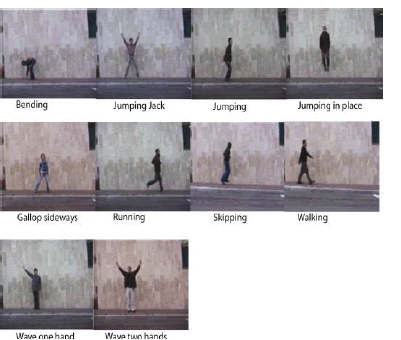 |
II.SECURE ROUTE OPTIMIZATION IN SMIPv6 USING ECGA AND DNSSEC |
| The main idea behind using DNSSEC and ECGA is to authenticate a message according to the domain from which it originated. This section first presents the objectives and assumptions of the proposals. Second, the integration of ECGA in the SMIPv6 is detailed execution in various MIPv6 scenarios leading to the RO. |
A. objectives |
| The objectives of the secure RO proposal are as follows |
| 1) Be as secure as HCBU while relying on the realistic assumptions. |
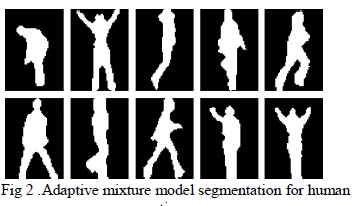 |
 |
| For CN to validate the CGCoA,it requires a signature involving MN,VHA,HA.MN sends a message 1 to Home agent, it checks with DNS.After making sure that the domain name is same, message 2 is sent to visiting home agent.vHA checks with mobile node, then the message 3 is transferred to corresponding node.MN’s new CGCoA must authenticate with corresponding, when the handover is executed inside the same network.Otherwise new vHA has to be signed,thus connection becomes invalid and route optimization execution must start from beginning. |
| The symmetric key KMN-CN,along with the signed visited token,is used to authenticate MN’s new CGCoA to the CN when the handover has been executed inside the same visited domain.Otherwise,the Auth token must be signed by the new vHA,and thus becomes invalid and the RO execution must starts from the beginning. |
D.Flush Request for SMIPv6 |
| When the MN detaches from its visited network while leaving ongoing flows active,vHA informs the CNs to stop sending their flow with a Flush request(FR)message |
| FR(CN\CGCoA\CGCoA Param)\CGvHA Param)\CGvHA Sign |
III.SECURITY VALIDATION OF SMIPv6 |
| The executions in the home and visited networks,the BT and the RO of SMIPv6 have been implemented in NS- 2,runned by the VMware(virtual machine).The TCL coding is simulated in the virtual machine.The following coding is to setup ns and topology object. |
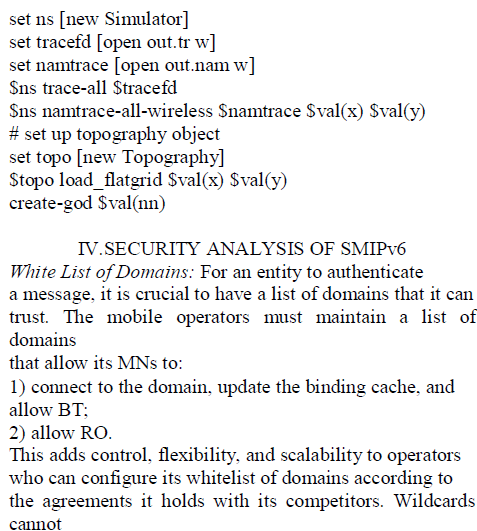 |
V. OUTPUTS AND GRAPH |
| Mobile node(MN) generates cryptographically generated home address(CGHA) and submit in home agent(HA).HA sends acknowledgement regarding storage success to MN.MN sends communication request to HA.HA sends fully qualified domain name(FQDN) to MN.HA adds the MN IP in the white list. After this the transferring of data packets takes place. weak authentication to ensure sender invariance of the router advertisement messages strong authentication for all other messages sent from the MN, HA, VHA and the DNS server. |
| secrecy to ensure confidentiality of symmetric keys held by the MN and shared with its HA and the CNs.DNSSEC enables a node to securely verify if a CGA is part of a trusted domain. Given that a CGA cannot be spoofed, receiving a message from a CGA signed by a trusted entity(HA/VHA) of a trusted domain increases the security property to strong authentication instead of sender invariance. |
 |
| However, because no assumption has been given about the knowledge of trusted domains to the MN, it must rely initially on the sender invariance property for the router advertisements. Note that the sender invariance is implemented in NS2 using the weak authentication on goal along with a witness and request security predicates using the message’s source identity as the authenticator and the authenticated. |
| The previous paper uses the AVANTSSAR tool for performing this route optimization and bidirectional tunneling method.The proposed system uses the network simulation software for performing the optimization algorithm.So this algorithm works better in network simulation software. |
GRAPH |
| The curve denotes the packets transfer rate for the corresponding simulation time.At starting the initialization process is going on,so the packet transfer does not takes place.upto 100th point there is no transfer of packects,only communication request takes place between home agent and mobile node and between server and mobile node.After these process only tranfer of packets takes place.The curve increases corresponding to the simulation time. |
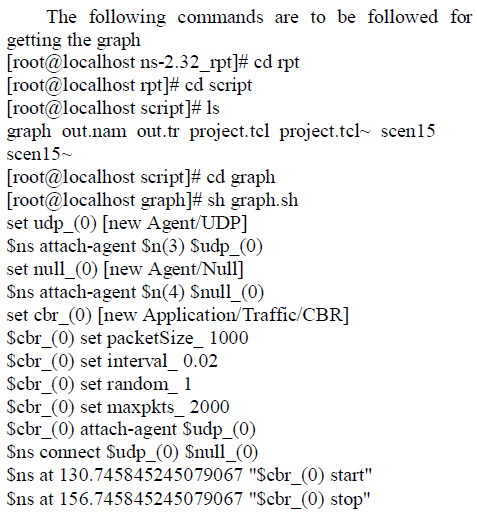 |
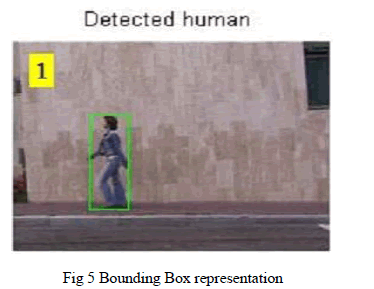 |
VI. CONCLUSION AND FUTURE WORK |
| This paper proposed a secure MIPv6 (SMIPv6) that includes a new secure and efficient RO using an ECGA to tackle the RR weaknesses and the unrealistic assumptions of existing works. Moreover, the use of trusted domains allowed the HA, VHA, and CN to strongly authenticate all incoming messages, thus tackling all major attacks while relying on realistic assumptions and keeping the radio signaling overhead to a minimum. And also the future work includes session continuity during rapid handover. The way of implementation is done by mobility monitoring,vHA analysis and finally handover to VHA.There MN’s services continue without any interruption. Results are simulated using network simulation. |
References |
|